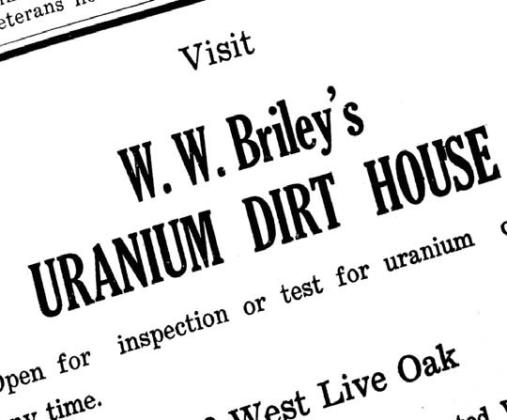After the dropping of the atomic bombs, ending the war with Japan, nuclear science was in the news on a regular basis. The Atomic Energy Commission was offering bonuses to those who found new sources of uranium for the Department of Defense. Prospectors began searching across the western United States hoping to get rich. Two prospectors arrived at Jesse Reese’s door in Comanche County asking if they could lease his land and search for uranium there. Jesse said no, but he thought he would investigate if there was something to this uranium on his land. Jesse took a box of his dirt to Austin to have it tested for uranium ore. It turned out it did have some radioactivity but it was not anymore radioactive than other dirt. (Weatherford Democrat, Crazy Dirt: The benefits of sitting in uranium dirt-ore not.)
But word got around that there might be uranium on his farm. A man was visiting in Comanche County who had been getting experimental radiation treatments in Washington. He asked if he could sit in the dirt on Reese’s farm so it might help his rheumatism. The next thing the Reese family knew, people started arriving, asking if they could sit in the dirt for relief.
In 1955 we still didn’t know a lot about nuclear radiation and how it affected the body. Some believed that they could lay in dirt that had a high uranium content and be temporarily healed from health problems. Some would bury themselves up to their neck in the dirt and believed pain and swelling from arthritis would be eliminated by the radiation. If it worked in Comanche County, it would probably work in Dublin. A gentleman here in town decided he would try it. W.W. Briley created a dirt house on West Live Oak Street in Dublin. The dirt that was brought in was genuine Comanche County dirt. The ad in the Dublin Progress stated that the dirt was tested weekly. The ad did not state who tested it or what they were testing for. (The Dublin Progress, September 30, 1955) Locally, people looking for a cure when medical authorities couldn’t help would seek out an alternative form of treatment. People would pay $2 dollars to sit in a uranium house for an hour and one-half. Some claimed that their arthritus was better afterward. Some couldn’t tell if they were any better. These uranium houses also sold bags of uranium dirt to go. Some houses had signs for “uranitoriums.”
Family members of a uranium house in Comanche County said that they probably made more money selling hamburgers and hot dogs to visitors than from the uranium dirt. (The Reese’s grandson, James Cowan interview) Despite what health effects were claimed, there probably wasn’t enough uranium in the soil in Erath or Comanche County to make much difference. Of the main sources of uranium in the United States, none of them are in Texas.

